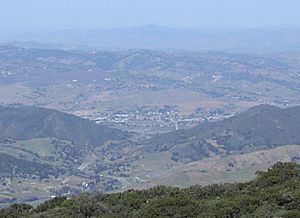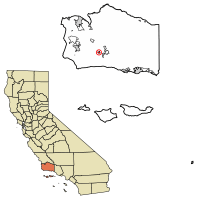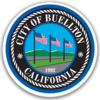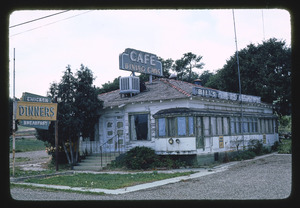Buellton, California facts for kids
Quick facts for kids
Buellton, California
|
|||
|---|---|---|---|

Buellton, as seen from near Gaviota Peak in the Santa Ynez Mountains
|
|||
|
|||

Location of Buellton in Santa Barbara County, California.
|
|||
| Country | United States | ||
| State | California | ||
| County | Santa Barbara | ||
| Incorporated | February 1, 1992 | ||
| Area | |||
| • Total | 1.58 sq mi (4.10 km2) | ||
| • Land | 1.58 sq mi (4.10 km2) | ||
| • Water | 0.00 sq mi (0.00 km2) 0.04% | ||
| Elevation | 358 ft (109 m) | ||
| Population
(2020)
|
|||
| • Total | 5,161 | ||
| • Density | 3,266.46/sq mi (1,258.78/km2) | ||
| Time zone | UTC-8 (PST) | ||
| • Summer (DST) | UTC-7 (PDT) | ||
| ZIP code |
93427
|
||
| Area code(s) | 805 | ||
| FIPS code | 06-08758 | ||
| GNIS feature ID | 1667902 | ||
Buellton is a small city in Santa Barbara County, California, in the United States. It is located in the beautiful Santa Ynez Valley, about 3 miles (4.8 km) west of Solvang. In 2020, about 5,161 people lived there. This was an increase from 4,828 people in 2010.
Buellton is a popular stop for travelers. It sits right where U.S. Route 101 and State Route 246 meet. The city has many hotels, restaurants, parks, and shops. It was once famous for its nickname "Home of Split Pea Soup," because of the old Pea Soup Andersen's Restaurant. Buellton started in 1867 when Rufus T. Buell and his brother bought land and built a successful cattle ranch.
Contents
History of Buellton
Buellton gets its name from Rufus T. Buell. He was an early settler who owned a large piece of land called the Rancho San Carlos de Jonata. Buellton became a small tourist spot in the 1920s. It grew even more popular after the Pea Soup Andersen's restaurant opened in 1924. Because it had so many places for travelers to stay and eat, Buellton was nicknamed "Servicetown, USA."
The city also became more well-known after the movie Sideways was filmed there in 2004. Many scenes were shot in Buellton and nearby Solvang. Today, people visit Buellton to explore its many wineries and two popular breweries. The Flying Flags RV Resort also brings many visitors to the area.
Geography and Nature
Buellton is surrounded by open land in the Santa Ynez Valley. The Santa Ynez River flows along its southern border. The city itself is about 1.6 square miles (4.1 square kilometers) in size. Almost all of it is land, with only a tiny bit of water.
The city has a library, a park, a golf course, a fire station, and a Highway Patrol Office. You can also find a shopping plaza, 10 hotels, and 18 restaurants here. Buellton is a common place for people to stop when driving on U.S. Highway 101. It's the first town you reach north of Santa Barbara after driving through about 25 miles (40 km) of undeveloped land along the Gaviota Coast.
Population Facts
| Historical population | |||
|---|---|---|---|
| Census | Pop. | %± | |
| 1970 | 1,402 | — | |
| 1980 | 2,364 | 68.6% | |
| 1990 | 3,506 | 48.3% | |
| 2000 | 3,828 | 9.2% | |
| 2010 | 4,828 | 26.1% | |
| 2020 | 5,161 | 6.9% | |
| U.S. Decennial Census | |||
In 2010, Buellton had a population of 4,828 people. Most residents were White, and about 30% were Hispanic or Latino. The population included people of all ages, from young children to seniors. In 2020, the population grew to 5,161 people.
Schools in Buellton
Buellton has two schools that are part of the Buellton Union School District.
- Oak Valley Elementary School teaches students from transitional kindergarten through 5th grade.
- Jonata Middle School serves students in grades 6 through 8.
About 600 students attend these schools. In 2019, Jonata Middle School was recognized as a California Distinguished School. The entire Buellton Union Elementary School District was named a California Exemplary District.
Older students in Buellton attend Santa Ynez Valley Union High School. This high school is located in the nearby town of Santa Ynez.
Getting Around
You can travel to and from Buellton using Amtrak Thruway buses. These buses stop at 237 East Highway 246. They connect to the Santa Barbara train station, where you can find Amtrak trains and FlixBus services.
Fun Activities
OstrichLand USA
OstrichLand USA is a fun place to visit near Buellton. It's a large farm, about 33 acres (13 hectares), where you can see ostriches and emus. Visitors can watch these big birds and even feed them!
See also
 In Spanish: Buellton (California) para niños
In Spanish: Buellton (California) para niños





